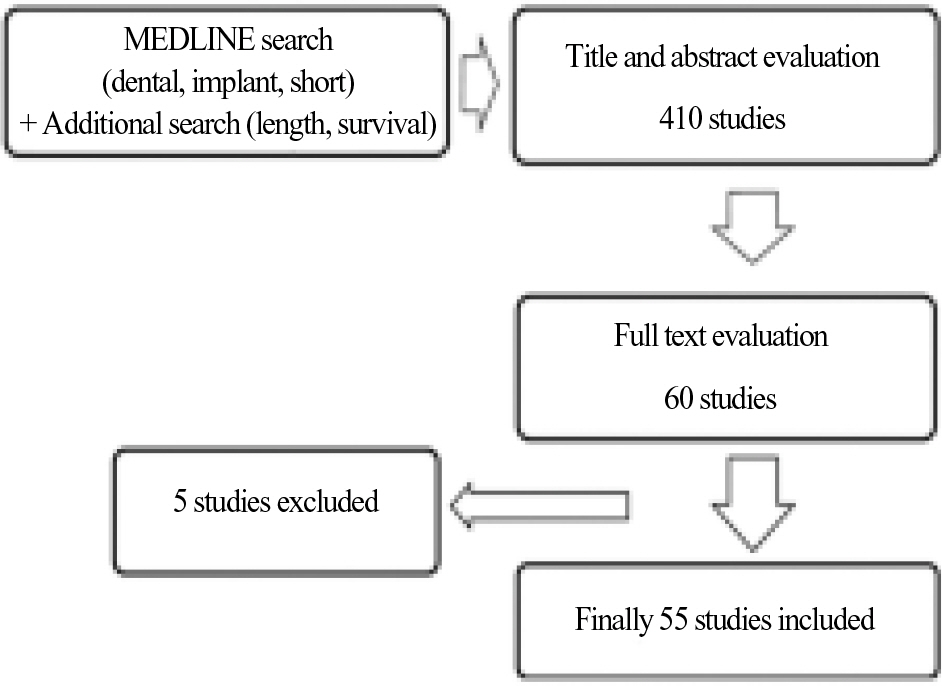J Korean Acad Prosthodont.
2009 Oct;47(4):457-462. 10.4047/jkap.2009.47.4.457.
A systematic review of the survival rate on short implants
- Affiliations
-
- 1Department of Dentistry, College of Medicine, Inha University, Korea. onsdo@inha.ac.kr
- KMID: 2195594
- DOI: http://doi.org/10.4047/jkap.2009.47.4.457
Abstract
- PURPOSE
The objective of this systematic review was to obtain the comprehensive survival rates of short implants. Then it was examined that whether treatment using short implants has favorable results.
METHODS
A MEDLINE search was performed, the data obtained from many articles about length, diameter, site of placement, surface treatment and prosthetic design were analyzed.
Results
and discussion: The data obtained from many articles were analyzed, and it was found that the survival rate of short implants was 95.87%, short implants has similar outcomes to those reported for standard implants. On the other hand, in the comparison the survival rate of 3 groups divided by the diameter of implants under 4 mm, 4 - 5 mm, and above 5 mm, a statistically significant difference was detected in under 4mm group. In implant group with 6 - 7 mm length, a group with 5 - 6 mm diameter has survival rate of 97.01%, groups with 3.1 - 4.8 mm diameter has survival rate of 92.96%, which was statistically significantly different. In the result of surface feature, the roughed surface groups of short implant showed a higher survival rate by approximately 6.3% than machined surface group. In the result of prosthetic design, survival rate of short implant was considerably lower for the single implant crown group (94.3%) than splinting group (99.4%).
Keyword
MeSH Terms
Figure
Cited by 1 articles
-
Retrospective clinical study on sinus bone graft and tapered-body implant placement
Jong-Hwa Kim, Young-Kyun Kim, Ji-Hyun Bae
J Korean Assoc Oral Maxillofac Surg. 2013;39(2):77-84. doi: 10.5125/jkaoms.2013.39.2.77.
Reference
-
1.Lindquist LW., Carlsson GE., Jemt T. A prospective 15-year follow-up study of mandibular fixed prostheses suppoted by osseointegrated implants. Clinical results and marginal bone loss. Clin Oral Implants Res. 1996. 7:329–36.2.Lemmerman KJ., Lemmerman NE. Osseointegrated dental implants in private practice: A long-term case series study. J Periodontol. 2005. 76:310–9.
Article3.Strong JT., Misch CE., Birdez MW., Nalluri P. Functional surface area: Thread form parameter optimization for implant body design. Compendium. 19:1998.4.Schnitman PA., Rubenstein JE., Who ¨rle PS., Dasilva JD., Koch GG. Implants for partial edentulism. J Dent Educ. 1988. 52:725–38.
Article5.Minsk L., Polson A., Weisgold A., Rose LF., Sanavi F., Baumgarten H., Listgarten MA. Outcome failures of endosseous implants from a clinical training center. Compend Contin Educ Dent. 1996. 17:848–56.6.Lekholm U., Gro ¨ndahl K., Jemt T. Outcome of oral implant treatment in partially edentulous jaws followed 20 years in clinical function. Clin Implant Dent Relat Res. 2006. 8:178–86.
Article7.Weinberg LA., Kruger B. An evaluation of torque (moment) on implant/prosthesis with staggered buccal and lingual offset. Int J Periodontics Restorative Dent. 1996. 16:252–65.8.Lum LB., Osier JF. Load transfer from endosteal implants to supporting bone: an analysis using statics. Part one: Horizontal loading. J Oral Implantol. 1992. 18:343–53.9.Lum LB. A biomechanical rationale for the use of short implants. J Oral Implantol. 1991. 17:126–31.10.Sertgo ¨z A., Gu ¨vener S. Finite element analysis of the effect of cantilever and implant length on stress distribution in an implant-supported fixed prosthesis. J Prosthet Dent. 1996. 76:165–9.11.Davarpanah M., Martinez H., Etienne D., Zabalegui I., Mattout P., Chiche F., Michel JF. A prospective multicenter evaluation of 1,583 3i implants: 1- to 5-year data. Int J Oral Maxillofac Implants. 2002. 17:820–8.12.Goene 、R., Bianchesi C., Hu ¨erzeler M., Del Lupo R., Testori T., Davarpanah M., Jalbout Z. Performance of short implants in partial restorations: 3-year follow-up of Osseotite implants. Implant Dent. 2005. 14:274–80.13.Feldman S., Boitel N., Weng D., Kohles SS., Stach RM. Five-year survival distributions of short-length (10 mm or less) machined-surfaced and Osseotite implants. Clin Implant Dent Relat Res. 2004. 6:16–23.
Article
- Full Text Links
- Actions
-
Cited
- CITED
-
- Close
- Share
- Similar articles
-
- Survival of surface-modified short versus long implants in complete or partially edentulous patients with a follow-up of 1 year or more: a systematic review and meta-analysis
- Outcomes of dental implant treatment in patients with generalized aggressive periodontitis: a systematic review
- Short dental implants in the posterior maxilla: a review of the literature
- Number of implants for mandibular implant overdentures: a systematic review
- A retrospective clinical study of single short implants (less than 8 mm) in posterior edentulous areas


